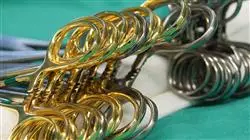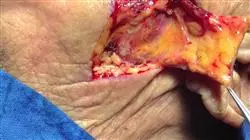University certificate
The world's largest faculty of nursing”
Introduction to the Program
Improve your knowledge through this program, where you will find the best didactic material with real clinical cases. Learn here about the latest advances in the specialty to be able to perform a quality practice”

Each of the wide variety of surgical interventions that are performed requires a specific procedure, a specific technique and the exclusive surgical material for that intervention. One thing they all have in common is a series of steps and rules that all team members should know in detail. They must also know the general functioning of the surgical department in order to prevent and avoid common risks while carrying out professional work.
This Postgraduate diploma contains the most complete and updated scientific program on the market, with the main objective of training in generic and specific competencies in a surgical process and facilitates the updating of the professional in a practical way and adapted to their needs. The modules that make up this course are aimed at updating the knowledge of nursing professionals who already perform their functions in the surgical field and for those new professionals who wish to develop their functions in the surgical field where a high qualification is required and increase their professional competence in the provision of surgical nursing care to the patient, before, during and after surgery in a holistic manner.
The innovative educational method, which includes real clinical cases and exercises to bring the development of the program closer to the surgical practice, is based on Problem Based Learning, by means of which the student must try to solve the different professional practice situations that arise during the program. For this reason, you will be assisted by an innovative interactive video system created by renowned and experienced experts in the field of radiology with extensive teaching experience.
This knowledge will facilitate the provision of quality care throughout the surgical process to ensure the safety of the patient and the professional at all times.
The content is based on the latest scientific evidence and is organized in a didactic way to integrate theoretical knowledge into nursing practice. The theoretical-practical elements allow professionals to update their knowledge and help them to make the right decisions in patient care.
Increase your skills in the approach to Plastic and Maxillofacial Surgery for Nurses through this program"
This Postgraduate diploma in Plastic and Maxillofacial Surgery for Nurses contains the most complete and updated scientific program on the market. The most important features of the program include:
- Clinical cases presented by experts in the different specialties. The graphic, schematic, and eminently practical contents with which they are created, provide provide scientific and healthcare training on those disciplines that are essential to professional practice
- Novelties on Plastic and Maxillofacial Surgery for Nurses
- Algorithm-based interactive learning system for decision-making in the presented clinical situations
- With special emphasis on evidence-based health and surgical nursing research methodologies
- All this will be complemented by theoretical lessons, questions to the expert, debate forums on controversial topics, and individual reflection assignments
- Content that is accessible from any fixed or portable device with an Internet connection
This Postgraduate diploma may be the best investment you can make in the selection of a refresher program for two reasons: in addition to updating your knowledge in Plastic and Maxillofacial Surgery for Nurses, you will obtain a Postgraduate diploma from TECH Global University"
Forming part of the teaching staff is a group of professionals in the world of surgical nursing who bring to this training their work experience, as well as a group of renowned specialists, recognised by esteemed scientific communities.
The multimedia content developed with the latest educational technology will provide the professional with situated and contextual learning, i.e., a simulated environment that will provide immersive training program to train in real situations.
This program is designed around Problem Based Learning, whereby the physician must try to solve the different professional practice situations that arise during the course. For this reason, you will be assisted by an innovative, interactive video system created by renowned and experienced experts in the field of surgical nursing with extensive teaching experience.
Increase your decision-making confidence by updating your knowledge with this Postgraduate diploma in Plastic and Maxillofacial Surgery for Nurses”

Don't miss the opportunity to update your knowledge in Plastic and Maxillofacial Surgery for Nurses to improve patient care”
Why study at TECH?
TECH is the world’s largest online university. With an impressive catalog of more than 14,000 university programs available in 11 languages, it is positioned as a leader in employability, with a 99% job placement rate. In addition, it relies on an enormous faculty of more than 6,000 professors of the highest international renown.

Study at the world's largest online university and guarantee your professional success. The future starts at TECH”
The world’s best online university according to FORBES
The prestigious Forbes magazine, specialized in business and finance, has highlighted TECH as “the world's best online university” This is what they have recently stated in an article in their digital edition in which they echo the success story of this institution, “thanks to the academic offer it provides, the selection of its teaching staff, and an innovative learning method aimed at educating the professionals of the future”
A revolutionary study method, a cutting-edge faculty and a practical focus: the key to TECH's success.
The most complete study plans on the university scene
TECH offers the most complete study plans on the university scene, with syllabuses that cover fundamental concepts and, at the same time, the main scientific advances in their specific scientific areas. In addition, these programs are continuously being updated to guarantee students the academic vanguard and the most in-demand professional skills. In this way, the university's qualifications provide its graduates with a significant advantage to propel their careers to success.
TECH offers the most comprehensive and intensive study plans on the current university scene.
A world-class teaching staff
TECH's teaching staff is made up of more than 6,000 professors with the highest international recognition. Professors, researchers and top executives of multinational companies, including Isaiah Covington, performance coach of the Boston Celtics; Magda Romanska, principal investigator at Harvard MetaLAB; Ignacio Wistumba, chairman of the department of translational molecular pathology at MD Anderson Cancer Center; and D.W. Pine, creative director of TIME magazine, among others.
Internationally renowned experts, specialized in different branches of Health, Technology, Communication and Business, form part of the TECH faculty.
A unique learning method
TECH is the first university to use Relearning in all its programs. It is the best online learning methodology, accredited with international teaching quality certifications, provided by prestigious educational agencies. In addition, this disruptive educational model is complemented with the “Case Method”, thereby setting up a unique online teaching strategy. Innovative teaching resources are also implemented, including detailed videos, infographics and interactive summaries.
TECH combines Relearning and the Case Method in all its university programs to guarantee excellent theoretical and practical learning, studying whenever and wherever you want.
The world's largest online university
TECH is the world’s largest online university. We are the largest educational institution, with the best and widest online educational catalog, one hundred percent online and covering the vast majority of areas of knowledge. We offer a large selection of our own degrees and accredited online undergraduate and postgraduate degrees. In total, more than 14,000 university degrees, in eleven different languages, make us the largest educational largest in the world.
TECH has the world's most extensive catalog of academic and official programs, available in more than 11 languages.
Google Premier Partner
The American technology giant has awarded TECH the Google Google Premier Partner badge. This award, which is only available to 3% of the world's companies, highlights the efficient, flexible and tailored experience that this university provides to students. The recognition as a Google Premier Partner not only accredits the maximum rigor, performance and investment in TECH's digital infrastructures, but also places this university as one of the world's leading technology companies.
Google has positioned TECH in the top 3% of the world's most important technology companies by awarding it its Google Premier Partner badge.
The official online university of the NBA
TECH is the official online university of the NBA. Thanks to our agreement with the biggest league in basketball, we offer our students exclusive university programs, as well as a wide variety of educational resources focused on the business of the league and other areas of the sports industry. Each program is made up of a uniquely designed syllabus and features exceptional guest hosts: professionals with a distinguished sports background who will offer their expertise on the most relevant topics.
TECH has been selected by the NBA, the world's top basketball league, as its official online university.
The top-rated university by its students
Students have positioned TECH as the world's top-rated university on the main review websites, with a highest rating of 4.9 out of 5, obtained from more than 1,000 reviews. These results consolidate TECH as the benchmark university institution at an international level, reflecting the excellence and positive impact of its educational model.” reflecting the excellence and positive impact of its educational model.”
TECH is the world’s top-rated university by its students.
Leaders in employability
TECH has managed to become the leading university in employability. 99% of its students obtain jobs in the academic field they have studied, within one year of completing any of the university's programs. A similar number achieve immediate career enhancement. All this thanks to a study methodology that bases its effectiveness on the acquisition of practical skills, which are absolutely necessary for professional development.
99% of TECH graduates find a job within a year of completing their studies.
Postgraduate Diploma in Plastic and Maxillofacial Surgery for Nurses
At TECH Global University we developed this Postgraduate Diploma in Plastic and Maxillofacial Surgery for Nurses with the aim of offering a unique training experience. Acquiring knowledge based on the latest scientific evidence and strengthening your care skills, you will have a wide preparation to take on the challenges that this discipline requires in its daily practice, boosting the development of your professional career towards a better working future.
Specialize in perioperative care and surgical assistance
The main objective of this program is to update the knowledge of our nursing students in advanced practice related to perioperative care of the different medical-surgical specialties. The program will provide you with the necessary tools and techniques to know the interventions that, as a nurse, you will develop during the whole period around surgery. In this way, you will acquire skills to communicate and manage the patient's anxiety or pain; you will know how to cooperate with the rest of the surgical team when necessary and you will master the anesthetic techniques together with the operation of the drugs that are administered. In that sense, you will have a high qualification to attend and collaborate in the different techniques of repair of facial defects required for each case.
Study at the largest Faculty of Nursing in the world
In this program you will have access to an updated scientific program, innovative methodologies for online study and the accompaniment of experts in the area through theoretical-practical classes and the study of real cases. Considering the importance of specialized education, at TECH Global University we distinguish ourselves by promoting accessible, flexible courses to suit the particular needs of each student.







